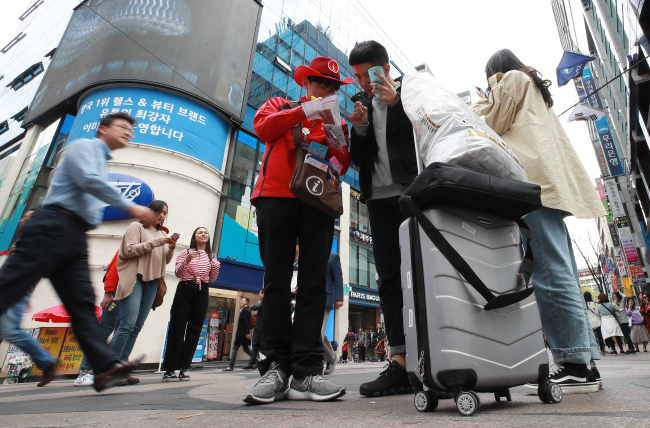Policymakers and private economists remain different in their forecasts on how fast the Korean economy will grow this year, following last year’s expansion of 3.1 percent.
Most private research institutes here expect the 2018 growth rate to hover below the government-set target of 3 percent.
A monthly report released by the Ministry of Strategy and Finance last week said Korea’s economy is maintaining a recovery momentum on the back of brisk exports and increased facility investment and private consumption.
“Industrial output, consumption and investment keep expanding backed by robust exports, and the current recovery pace is expected to continue,” said the report, called the “Green Book.”
With the country’s overall industrial output remaining flat in February, production in the mining and manufacturing sector rose for a second consecutive month.
Retail sales and facility investment increased 1 percent and 1.3 percent, respectively, in February.
Korea’s exports, which have been on an upward trend since November 2016, soared 6.1 percent in March from a year earlier mainly on the back of brisk sales of memory chips.
The report still cautioned that a weakening job market, possible rate hikes in the US and aggravating trade conditions are poised to weigh on the economy.
The Bank of Korea last week held up its growth outlook for this year, set at 3 percent in line with the government’s prediction.
In January, the central bank revised up its growth forecast for 2018 by 0.1 percentage point from 2.9 percent.
BOK Gov. Lee Ju-yeol told reporters the growth rate was projected to reach 3 percent this year, based on the review of internal and external conditions since January.
The central bank forecast private consumption would increase 2.7 percent and facility investment would gain 2.9 percent to bolster growth this year, while noting downside risks from global trade rows and the loosening local job market.
The growth forecast by the government and the BOK is on par with the outlook from international economic organizations.
Citing benefits from a recovery in major economies and increased private consumption, the Asian Development Bank recently kept its 2018 growth estimate for Korea at 3 percent, which has also been held up by the International Monetary Fund and the Organization for Economic Cooperation and Development.
However, private economists and business circles here have remained more cautious about the prospect of Korea’s economic growth.
“Uncertainties over the growth trend of the country are set to continue to increase down the road,” said Kang Seung-won, a researcher at NH Investment and Securities.
He predicted facility investment would slow at an increasingly steep pace after the second quarter of the year.
The declining factory operation rate, coupled with a rise in inventories, can be seen as portending a reduction in facility investment and a downturn in economic activity.
According to official data, factories around the country ran at 70.4 percent of full capacity on average in January, down from 73.5 percent in the first quarter of last year.
Goods in stock at domestic firms rose 8.7 percent in the January to February period, a sharp rise from 0.1 percent in the second quarter of 2017.
Three major private think tanks in the country -- Hyundai Research Institute, LG Economic Research Institute and Korea Economic Research Institute -- have forecast that Korea’s economy would grow no more than 2.8 percent this year.
The state-run Korea Development Institute has put its growth estimate at 2.9 percent.
Korean companies focused on exports are particularly concerned about the strengthening won that would hurt their profitability and trade disputes between the US and China, which could lead to reducing demands for their products.
The country avoided being labeled as a currency manipulator in the US Treasury Department’s biannual report released last week. But Seoul’s plan to disclose records on its intervention in the foreign exchange market under pressure from Washington and the IMF is expected to accelerate the appreciation of the won against the US dollar.
The strengthening of the won might give the BOK some room for further delaying additional interest rate hikes with the US Federal Reserve expected to raise its policy rate up to three more times this year following a 0.25 percentage point increase last month.
But a widening gap between interest rates in the two economies would put pressure on the BOK to increase its benchmark rate, which has been frozen at 1.5 percent since November.
Trade frictions between the US and China, which are set to go on due to strategic and structural reasons, could weigh on Korean exporters, who rely on the world’s two biggest economies for nearly 40 percent of their shipments abroad.
Economists also indicate that restructuring programs could undercut growth unless handled in an effective and timely manner.
Nevertheless, government policymakers remain optimistic on achieving their growth goal this year.
They seem to hope that additional boost will be provided by a proposed 3.9 trillion-won ($3.63 billion) supplementary budget designed to create more jobs for young people and a rebound in the number of inbound Chinese tourists.
The parliamentary passage of the extra spending plan is not guaranteed, as opposition lawmakers vow to block it. It is yet to be seen whether the inflow of Chinese travelers will continue to rise for the rest of the year following a 13.3 percent on-year increase in March.
The results of the upcoming summitry on dismantling Pyongyang’s nuclear arsenal are also expected to help bolster or dampen the prospect for the Korean economy this year and beyond.
By Kim Kyung-ho
(
khkim@heraldcorp.com)





![[Exclusive] Hyundai Mobis eyes closer ties with BYD](http://res.heraldm.com/phpwas/restmb_idxmake.php?idx=644&simg=/content/image/2024/11/25/20241125050044_0.jpg)
![[Herald Review] 'Gangnam B-Side' combines social realism with masterful suspense, performance](http://res.heraldm.com/phpwas/restmb_idxmake.php?idx=644&simg=/content/image/2024/11/25/20241125050072_0.jpg)

